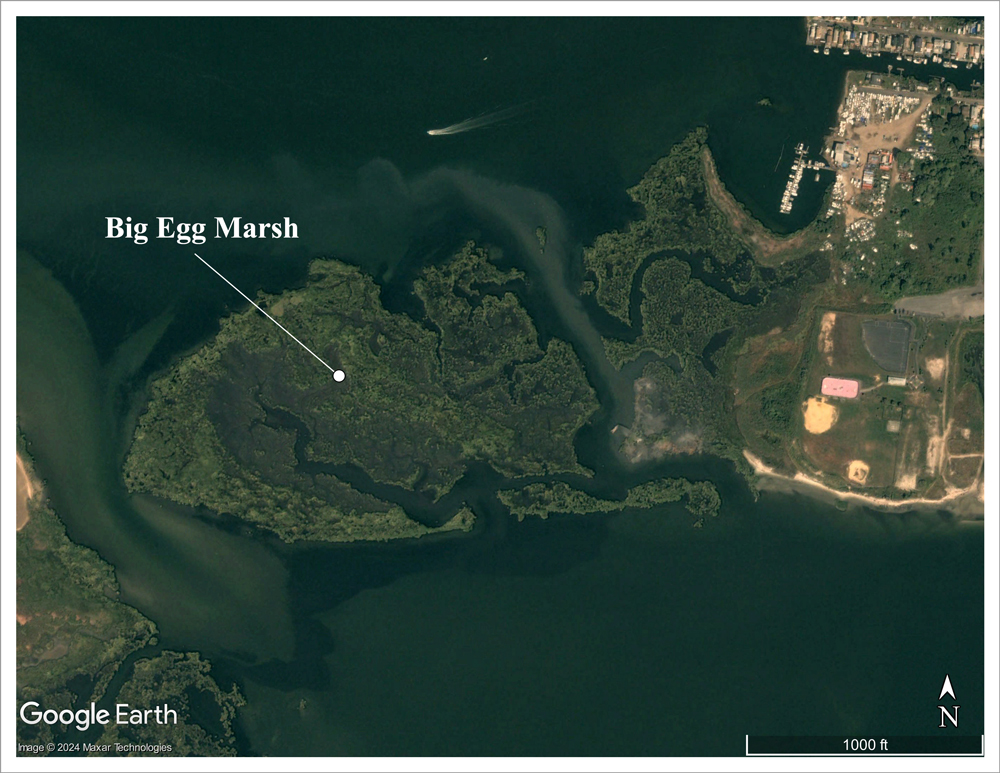Big Egg Marsh – Jamaica Bay

- Title: Big Egg Marsh – Jamaica Bay
- State: New York
- Project type: National Park Service and Gateway National Recreation Area
- Greater Beneficial Use Area: Jamaica Bay
- Focus Area approximate center coordinates: 40.5959, -73.8318
- Nearest Federal Navigation Project: Jamaica Bay Navigation Channel
- Owner: National Park Service
- Beneficial Use Categories: Aquatic habitats, Wetland Habitats
- Dredge type: Hydraulic
- Status: Completed
- Keywords: habitat development, thin layer placement, saltmarsh, erosion control, Gateway National Recreation Area
Description:
Saltmarshes are essential coastal habitats that provide nursery and feeding grounds for various fish and wildlife species, improve water quality, and protect coastal areas from storm events. Jamaica Bay, located in southeastern New York City and straddling the border between Brooklyn and Queens, encompasses a large urban estuary and lagoon complex. This includes 13 saltmarshes and the Jamaica Bay Wildlife Refuge, all within the Gateway National Recreation Area. Over the last century, Jamaica Bay has lost approximately 70% of its saltmarshes, with the bay losing over 40-acres of marsh annually since the early 2000s. This decline is attributed to several factors, including human encroachment, subsidence, sea-level rise, erosion, pollution, and plant mortality. Recognizing the urgent need for ecological intervention, the National Parks Service (NPS) and other local stakeholders have been seeking effective and sustainable methods for saltmarsh restoration.
In 1999, the Jamaica Bay Research and Restoration Team chose a 100-acre portion of the Big Egg Marsh in south Jamaica Bay for a pilot restoration project. The project employed an experimental technique at the time, known as thin layer placement of sediment. The chosen site, transitioning from smooth cordgrass (Spartina alterniflora) marsh to a bare mudflat, was an ideal candidate for this method. Smooth cordgrass serves as a health indicator for saltmarshes; its roots capture sediment, forming a nutrient-dense peat that promotes further plant growth and habitat stability.
The Big Egg Marsh pilot project, funded and led by NPS, involved collaboration with various federal, state, and local stakeholders, including US Army Corps of Engineers (USACE), New York State Department of Environmental Conservation (NYSDEC), New York City Department of Parks and Recreation, and the Aquatic Resources and Environmental Assessment Center at Brooklyn College. The primary goal was to evaluate the effectiveness of enhancing marsh elevation and promoting vegetation growth through the thin layer placement of dredged sediment and planting.
In 2003, the project team prepared the project area by installing containment barriers, then placed approximately 8,000 cubic yards of mostly sandy sediment on a two-acre portion of Big Egg Marsh. This sediment, dredged from an adjacent tidal creek using a swing-ladder dredge and a high-pressure spray, was dispersed over the project area using a 10-cm diameter high-pressure nozzle to minimize habitat disturbance. The sediment layer varied in thickness, up to 39 inches, based on the original and target elevations, with most areas receiving about eight inches. The target elevations ensured that the majority of the marsh was inundated by daily high tides, preventing the invasion of non-native common reed (Phragmites australis). Smooth cordgrass sourced from nearby Staten Island was densely planted and then protected with plastic fencing.
The experimental restoration project at Big Egg Marsh yielded several positive outcomes, including the survival and regrowth of smooth cordgrass and the colonization of the newly created saltmarsh by various species like fiddler crab (Uca sp.), eastern mud nassa (Ilyanassa obsolete), common periwinkle (Littorina littorea), as well as various fish, worm, and insect species. The project faced challenges such as damage to the protective fencing and erosion along the project perimeter. A significant finding was the inverse correlation between the survival of smooth cordgrass and sediment layers surpassing eight inches. Notably, there was no survival of smooth cordgrass when the thin layer’s thickness exceeded eight inches. This insight is an important lesson learned for future projects. Despite the challenges, by 2008, the treated site had successfully transformed into a silty-organic saltmarsh with dense smooth cordgrass coverage.
The Big Egg Marsh pilot project successfully transformed a barren mudflat into a thriving saltmarsh by addressing the challenges of marsh loss and engaging local stakeholders. The project involved over 200 volunteers, student interns, collaborators from government agencies, contractors, and NPS staff, demonstrating the potential of public participation in environmental stewardship. The NPS has since applied the findings from this project to similar restoration efforts in Jamaica Bay. Building on Big Egg’s success, the NPS has partnered with USACE and the Port Authority of New York and New Jersey, beneficially using dredged sediment and the thin layer placement techniques for continued revitalization of urban coastlines.
Further readings:
- Frame GW, Mellander K, Adamo D. (2005). Big Egg Marsh Experimental Restoration in Jamaica Bay, New York. In: People, Places, and Parks: Proceedings of the 2005 George Wright Society Conference on Parks, Protected Areas, and Cultural Sites. Hancock, MI: The George Wright Society.
- National Park Service. (2015). Marsh Restoration in Gateway. December 10.
- National Park Service. (2022). Introducing Jamaica Bay. March 25.
- USACE. (2016). Thin-Layer Placement Project Sheet: Jamaica Bay - Big Egg Marsh. USACE, Engineer Research and Development Center. August.
- Ye B. (2022). In the Field: Restoring Big Egg Marsh. National Park Service. March 25.
Website links:
- Cornell Lab of Ornithology. (2023). eBird: Jamaica Bay, Big Egg Marsh, Queens County, New York, US.
Videos:
- A Selection of Videos about Jamaica Bay. YouTube, Uploaded by Jamaica Bay-Rockaway Parks Conservancy.

